Combining Geostatistics and Remote Sensing Data to Improve Spatiotemporal Analysis of Precipitation
Abstract
1. Introduction
2. Methodology
2.1. Study Area and Data
2.2. Satellite Sensors Data
2.3. Space–Time Kriging Method
3. Results and Discussion
4. Conclusions
Author Contributions
Funding
Data Availability Statement
Acknowledgments
Conflicts of Interest
References
- Luo, S.; Chen, J.M.; Wang, C.; Gonsamo, A.; Xi, X.; Lin, Y.; Qian, M.; Peng, D.; Nie, S.; Qin, H. Comparative performances of airborne lidar height and intensity data for leaf area index estimation. IEEE J. Sel. Top. Appl. Earth Obs. Remote Sens. 2018, 11, 300–310. [Google Scholar] [CrossRef]
- Zhang, J.; Xiao, W.; Coifman, B.; Mills, J.P. Vehicle tracking and speed estimation from roadside lidar. IEEE J. Sel. Top. Appl. Earth Obs. Remote Sens. 2020, 13, 5597–5608. [Google Scholar] [CrossRef]
- Kulawiak, M.; Lubniewski, Z. Improving the accuracy of automatic reconstruction of 3d complex buildings models from airborne lidar point clouds. Remote Sens. 2020, 12, 1643. [Google Scholar] [CrossRef]
- Sorooshian, S.; Nguyen, P.; Sellars, S.; Braithwaite, D.; AghaKouchak, A.; Hsu, K. Satellite-based remote sensing estimation of precipitation for early warning systems. In Extreme Natural Hazards, Disaster Risks and Societal Implications; Ismail-Zadeh, A., Kijko, A., Zaliapin, I., Urrutia Fucugauchi, J., Takeuchi, K., Eds.; Cambridge University Press: Cambridge, UK, 2014; pp. 99–112. [Google Scholar]
- Nguyen, P.; Shearer, E.J.; Tran, H.; Ombadi, M.; Hayatbini, N.; Palacios, T.; Huynh, P.; Braithwaite, D.; Updegraff, G.; Hsu, K.; et al. The chrs data portal, an easily accessible public repository for persiann global satellite precipitation data. Sci. Data 2019, 6, 180296. [Google Scholar] [CrossRef] [PubMed]
- Hong, Y.; Hsu, K.-L.; Sorooshian, S.; Gao, X. Precipitation estimation from remotely sensed imagery using an artificial neural network cloud classification system. JApMe 2004, 43, 1834–1853. [Google Scholar] [CrossRef]
- Xie, P.; Joyce, R.; Wu, S.; Yoo, S.-H.; Yarosh, Y.; Sun, F.; Lin, R. Noaa cdr Program (2019): Noaa Climate Data Record (cdr) of Cpc Morphing Technique (cmorph) High Resolution Global Precipitation Estimates, 1st ed.; NOAA National Centers for Environmental Information: Boulder, CO, USA, 2019. [Google Scholar]
- Mathbout, S.; Lopez-Bustins, J.A.; Royé, D.; Martin-Vide, J.; Bech, J.; Rodrigo, F.S. Observed changes in daily precipitation extremes at annual timescale over the eastern mediterranean during 1961–2012. Pure Appl. Geophys. 2018, 175, 3875–3890. [Google Scholar] [CrossRef]
- Mathbout, S.; Lopez-Bustins, J.A.; Royé, D.; Martin-Vide, J.; Benhamrouche, A. Spatiotemporal variability of daily precipitation concentration and its relationship to teleconnection patterns over the mediterranean during 1975–2015. Int. J. Clim. 2020, 40, 1435–1455. [Google Scholar] [CrossRef]
- Hoegh-Guldberg, O.; Jacob, D.; Taylor, M.; Bindi, M.; Brown, S.; Camilloni, I.; Diedhiou, A.; Djalante, R.; Ebi, K.; Engelbrecht, F. Impacts of 1.5 °C global warming on natural and human systems. In Global Warming of 1.5 °C. An IPCC Special Report on the Impacts of Global Warming of 1.5 °C above Pre-Industrial Levels and Related Global Greenhouse Gas Emission Pathways, in the Context of Strengthening the Global Response to the Threat of Climate Change, Sustainable Development, and Efforts to Eradicate Poverty; Masson-Delmotte, V.P., Zhai, H.-O., Pörtner, D., Roberts, J., Skea, P.R., Shukla, A., Pirani, W., Moufouma-Okia, C., Péan, R., Pidcock, S., et al., Eds.; IPCC Secretariat: Geneva, Switzerland, 2018; pp. 175–311. [Google Scholar]
- Nastos, P.T.; Politi, N.; Kapsomenakis, J. Spatial and temporal variability of the aridity index in greece. Atmos. Res. 2013, 119, 140–152. [Google Scholar] [CrossRef]
- Founda, D.; Varotsos, K.; Pierros, F.; Giannakopoulos, C. Observed and projected shifts in hot extremes’ season in the eastern mediterranean. Glob. Planet. Chang. 2019, 175, 190–200. [Google Scholar] [CrossRef]
- Varouchakis, E.A.; Hristopulos, D.T.; Karatzas, G.P.; Corzo Perez, G.A.; Diaz, V. Spatiotemporal geostatistical analysis of precipitation combining ground and satellite observations. Hydrol. Res. 2021. [Google Scholar] [CrossRef]
- Kalimeris, A.; Kolios, S. Trmm-based rainfall variability over the central mediterranean and its relationships with atmospheric and oceanic climatic modes. Atmos. Res. 2019, 230, 104649. [Google Scholar] [CrossRef]
- Peña-Angulo, D.; Nadal-Romero, E.; González-Hidalgo, J.C.; Albaladejo, J.; Andreu, V.; Bahri, H.; Bernal, S.; Biddoccu, M.; Bienes, R.; Campo, J.; et al. Relationship of weather types on the seasonal and spatial variability of rainfall, runoff, and sediment yield in the western mediterranean basin. Atmos 2020, 11, 609. [Google Scholar] [CrossRef]
- Kim, G.-U.; Seo, K.-H.; Chen, D. Climate change over the mediterranean and current destruction of marine ecosystem. Sci. Rep. 2019, 9, 18813. [Google Scholar] [CrossRef] [PubMed]
- Eshel, G.; Farrell, B.F. Mechanisms of eastern mediterranean rainfall variability. J. Atmos. Sci. 2000, 57, 3219–3232. [Google Scholar] [CrossRef]
- Lelieveld, J.; Hadjinicolaou, P.; Kostopoulou, E.; Chenoweth, J.; El Maayar, M.; Giannakopoulos, C.; Hannides, C.; Lange, M.A.; Tanarhte, M.; Tyrlis, E.; et al. Climate change and impacts in the eastern mediterranean and the middle east. Clim. Chang. 2012, 114, 667–687. [Google Scholar] [CrossRef]
- Hatzianastassiou, N.; Katsoulis, B.; Pnevmatikos, J.; Antakis, V. Spatial and temporal variation of precipitation in greece and surrounding regions based on global precipitation climatology project data. J. Clim. 2008, 21, 1349–1370. [Google Scholar] [CrossRef]
- Maheras, P.; Tolika, K.; Anagnostopoulou, C.; Vafiadis, M.; Patrikas, I.; Flocas, H. On the relationships between circulation types and changes in rainfall variability in greece. Int. J. Clim. 2004, 24, 1695–1712. [Google Scholar] [CrossRef]
- Tapoglou, E.; Vozinaki, A.E.; Tsanis, I. Climate change impact on the frequency of hydrometeorological extremes in the island of crete. Water 2019, 11, 587. [Google Scholar] [CrossRef]
- Tzanakakis, V.A.; Angelakis, A.N.; Paranychianakis, N.V.; Dialynas, Y.G.; Tchobanoglous, G. Challenges and opportunities for sustainable management of water resources in the island of crete, greece. Water 2020, 12, 1538. [Google Scholar] [CrossRef]
- Varouchakis, E.A.; Corzo, G.A.; Karatzas, G.P.; Kotsopoulou, A. Spatio-temporal analysis of annual rainfall in crete, greece. Acta Geophys. 2018, 66, 319–328. [Google Scholar] [CrossRef]
- Biondi, F. Space-time kriging extension of precipitation variability at 12 km spacing from tree-ring chronologies and its implications for drought analysis. Hydrol. Earth Syst. Sci. Discuss. 2013, 10, 4301–4335. [Google Scholar]
- Hu, D.-G.; Shu, H. Spatiotemporal interpolation of precipitation across xinjiang, china using space-time cokriging. J. Cent. South. Univ. 2019, 26, 684–694. [Google Scholar] [CrossRef]
- Hu, D.; Shu, H.; Hu, H.; Xu, J. Spatiotemporal regression kriging to predict precipitation using time-series modis data. Clust. Comput. 2017, 20, 347–357. [Google Scholar] [CrossRef]
- Martínez, W.A.; Melo, C.E.; Melo, O.O. Median polish kriging for space–time analysis of precipitation. Spat. Stat. 2017, 19, 1–20. [Google Scholar] [CrossRef]
- Raja, N.B.; Aydin, O.; Türkoğlu, N.; Çiçek, I. Space-time kriging of precipitation variability in turkey for the period 1976–2010. Appl. Clim. 2017, 129, 293–304. [Google Scholar] [CrossRef]
- Subyani, A.M. Climate variability in space-time variogram models of annual rainfall in arid regions. Arab. J. Geosci. 2019, 12, 650. [Google Scholar] [CrossRef]
- Takafuji, E.H.d.M.; da Rocha, M.M.; Manzione, R.L. Spatiotemporal forecast with local temporal drift applied to weather patterns in patagonia. Sn Appl. Sci. 2020, 2, 1001. [Google Scholar] [CrossRef]
- Yang, X.; Yang, Y.; Li, K.; Wu, R. Estimation and characterization of annual precipitation based on spatiotemporal kriging in the huanghuaihai basin of china during 1956–2016. Stoch. Env. Res. Risk A 2019, 34, 1407–1420. [Google Scholar] [CrossRef]
- Zhang, Y.; Zheng, X.; Wang, Z.; Ai, G.; Huang, Q. Implementation of a parallel gpu-based space-time kriging framework. Isprs Int. J. Geo-Inf. 2018, 7, 193. [Google Scholar] [CrossRef]
- Naranjo-Fernández, N.; Guardiola-Albert, C.; Aguilera, H.; Serrano-Hidalgo, C.; Rodríguez-Rodríguez, M.; Fernández-Ayuso, A.; Ruiz-Bermudo, F.; Montero-González, E. Relevance of spatio-temporal rainfall variability regarding groundwater management challenges under global change: Case study in doñana (sw spain). Stoch. Env. Res. Risk A 2020, 34, 1289–1311. [Google Scholar] [CrossRef]
- Cassiraga, E.; Gómez-Hernández, J.J.; Berenguer, M.; Sempere-Torres, D.; Rodrigo-Ilarri, J. Spatiotemporal precipitation estimation from rain gauges and meteorological radar using geostatistics. Math. Geosci. 2020, 53, 499–516. [Google Scholar] [CrossRef]
- Li, M.; Shao, Q. An improved statistical approach to merge satellite rainfall estimates and raingauge data. J. Hydrol. 2010, 385, 51–64. [Google Scholar] [CrossRef]
- Verdin, A.; Funk, C.; Rajagopalan, B.; Kleiber, W. Kriging and local polynomial methods for blending satellite-derived and gauge precipitation estimates to support hydrologic early warning systems. IEEE Trans. Geosci. Remote Sens. 2016, 54, 2552–2562. [Google Scholar] [CrossRef]
- Tadić, J.M.; Qiu, X.; Miller, S.; Michalak, A.M. Spatio-temporal approach to moving window block kriging of satellite data v1.0. Geosci. Model Dev. 2017, 10, 709–720. [Google Scholar] [CrossRef]
- Militino, A.F.; Ugarte, M.D.; Pérez-Goya, U. An introduction to the spatio-temporal analysis of satellite remote sensing data for geostatisticians. In Handbook of Mathematical Geosciences: Fifty Years of Iamg; Daya Sagar, B.S., Cheng, Q., Agterberg, F., Eds.; Springer International Publishing: Cham, Switzerland, 2018; pp. 239–253. [Google Scholar]
- Special water secretariat of Greece. Integrated Management Plans of the Greek Watersheds; Ministry of Environment & Energy: Athens, Greece, 2017; p. 247. [Google Scholar]
- Agou, V.D.; Varouchakis, E.A.; Hristopulos, D.T. Geostatistical analysis of precipitation in the island of crete (greece) based on a sparse monitoring network. Env. Monit. Assess. 2019, 191, 353. [Google Scholar] [CrossRef] [PubMed]
- Lagouvardos, K.; Kotroni, V.; Bezes, A.; Koletsis, I.; Kopania, T.; Lykoudis, S.; Mazarakis, N.; Papagiannaki, K.; Vougioukas, S. The automatic weather stations noann network of the national observatory of athens: Operation and database. Geosci. Data J. 2017, 4, 4–16. [Google Scholar] [CrossRef]
- Sun, Q.; Miao, C.; Duan, Q.; Ashouri, H.; Sorooshian, S.; Hsu, K.-L. A review of global precipitation data sets: Data sources, estimation, and intercomparisons. Rev. Geophys. 2018, 56, 79–107. [Google Scholar] [CrossRef]
- Yu, L.; Zhang, Y.; Yang, Y. Using high-density rain gauges to validate the accuracy of satellite precipitation products over complex terrains. Atmos 2020, 11, 633. [Google Scholar] [CrossRef]
- Bárdossy, A.; Pegram, G. Interpolation of precipitation under topographic influence at different time scales. Water Resour. Res. 2013, 49, 4545–4565. [Google Scholar] [CrossRef]
- Gräler, B.; Pebesma, E.; Heuvelink, G. Spatio-temporal geostatistics using gstat. R J. 2015, 8, 204–218. [Google Scholar] [CrossRef]
- Heuvelink, G.B.M.; Pebesma, E.; Gräler, B. Space-time geostatistics. In Encyclopedia of Gis; Shekhar, S., Xiong, H., Zhou, X., Eds.; Springer International Publishing: Cham, Switzerland, 2017; pp. 1919–1926. [Google Scholar]
- Hoogland, T.; Heuvelink, G.B.M.; Knotters, M. Mapping water-table depths over time to assess desiccation of groundwater-dependent ecosystems in the netherlands. Wetlands 2010, 30, 137–147. [Google Scholar] [CrossRef]
- De Cesare, L.D.; Myers, D.E.; Posa, D. Estimating and modeling space-time correlation structures. Stat. Probabil. Lett. 2001, 51, 9–14. [Google Scholar] [CrossRef]
- De Iaco, S. Space-time correlation analysis: A comparative study. J. Appl. Stat. 2010, 37, 1027–1041. [Google Scholar] [CrossRef]
- Hristopulos, D.T.; Elogne, S.N. Analytic properties and covariance functions for a new class of generalized gibbs random fields. IEEE Trans. Inf. Theory 2007, 53, 4667–4679. [Google Scholar] [CrossRef]
- Wadoux, A.M.J.C.; Brus, D.J.; Rico-Ramirez, M.A.; Heuvelink, G.B.M. Sampling design optimisation for rainfall prediction using a non-stationary geostatistical model. Adv. Water Resour. 2017, 107, 126–138. [Google Scholar] [CrossRef]
- Lebrenz, H.; Bárdossy, A. Geostatistical interpolation by quantile kriging. Hydrol. Earth Syst. Sci. 2019, 23, 1633–1648. [Google Scholar] [CrossRef]
- Naoum, S.; Tsanis, I.K. Temporal and spatial variation of annual rainfall on the island of crete, greece. Hydrol. Process. 2003, 17, 1899–1922. [Google Scholar] [CrossRef]
- Tzoraki, O.; Kritsotakis, M.; Baltas, E. Spatial water use efficiency index towards resource sustainability: Application in the island of crete, greece. Int. J. Water Resour. Dev. 2015, 31, 669–681. [Google Scholar] [CrossRef]
- Voudouris, K.; Mavrommatis, T.; Daskalaki, P.; Soulios, G. Rainfall variations in crete island (greece) and their impacts on water resources. Publ. Del Inst. Geol. Y Min. De Esp. Ser. Hidrogeol. Y Aguas Subterráneas 2006, 18, 453–463. [Google Scholar]
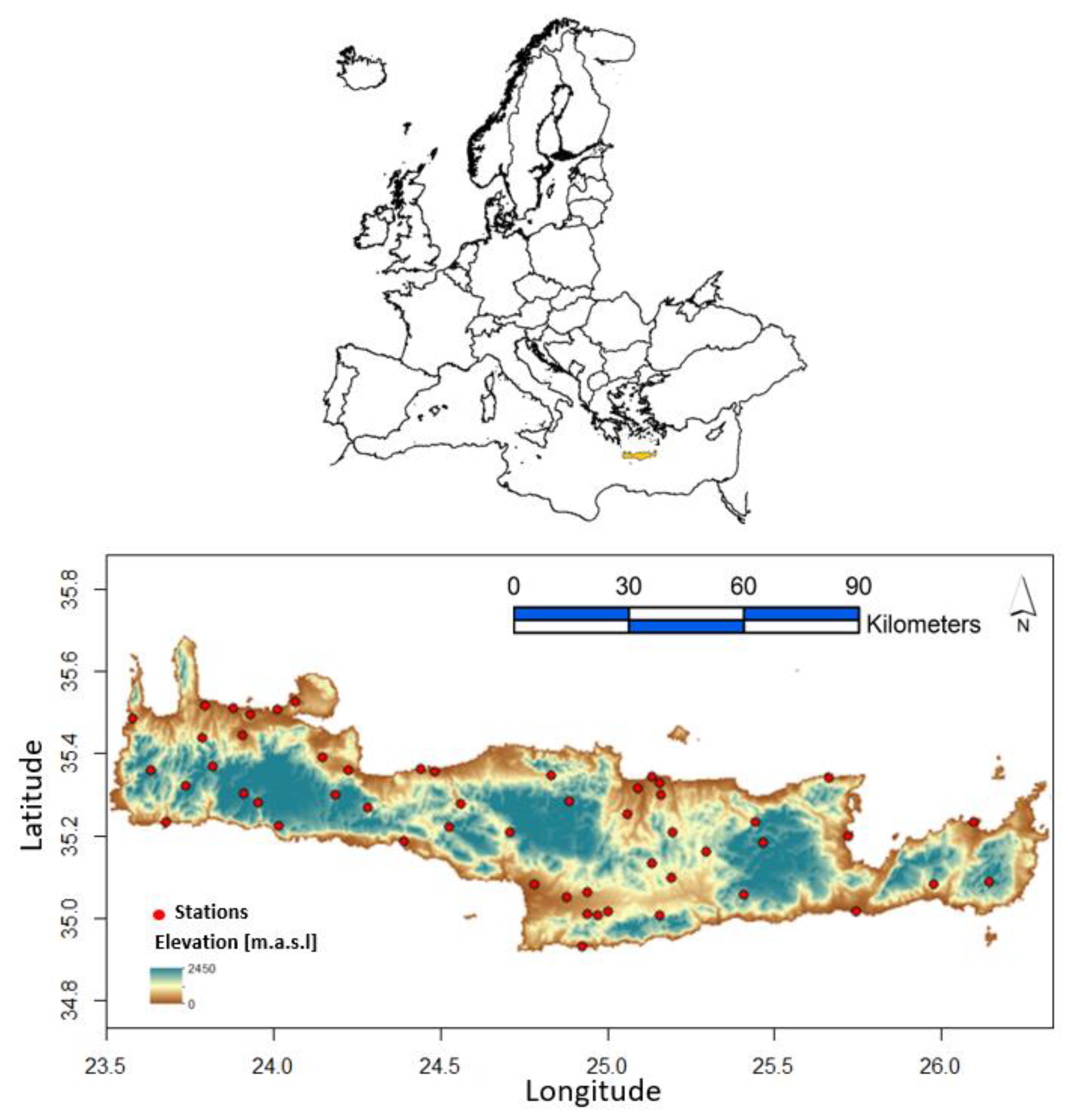

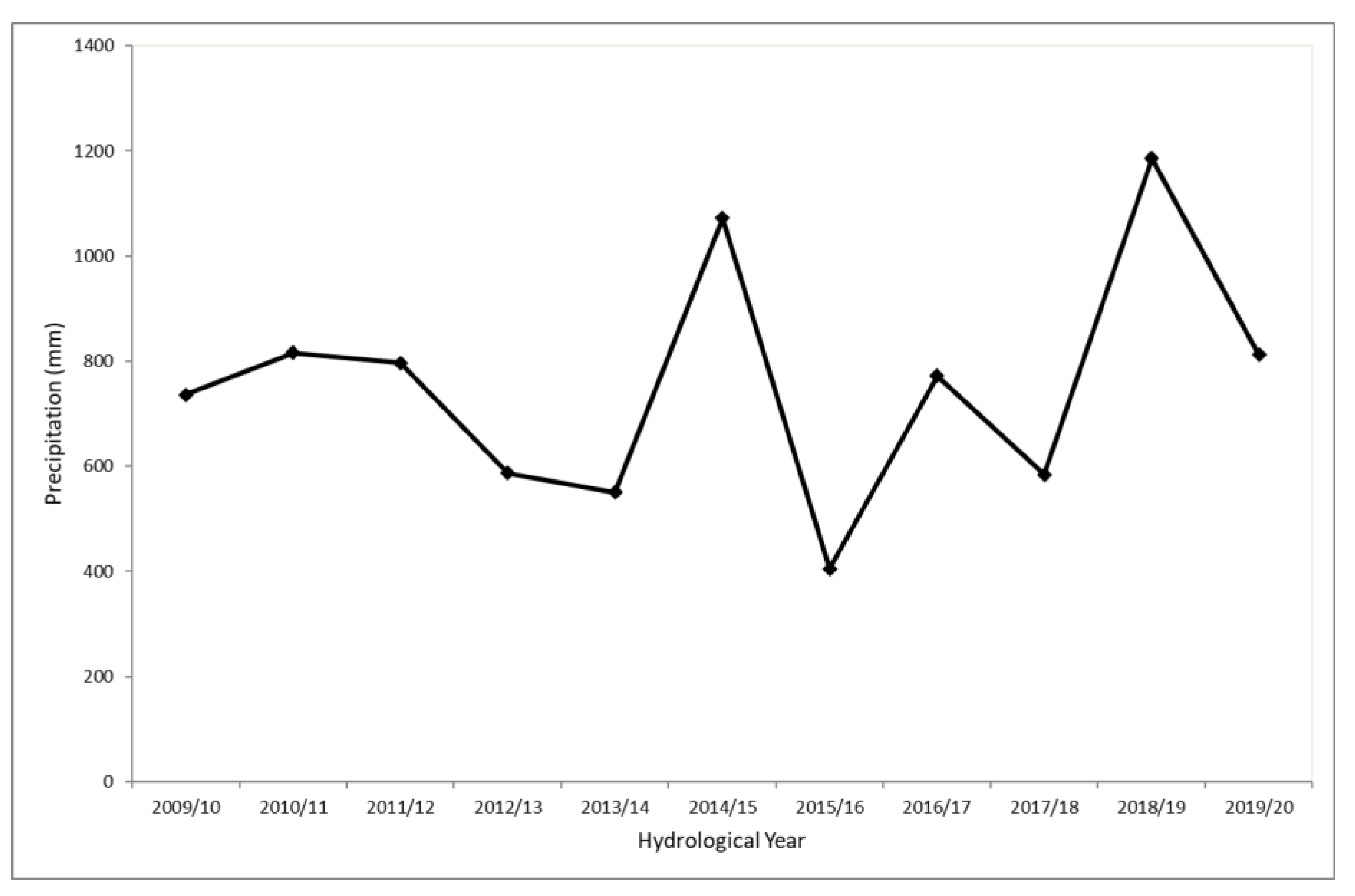
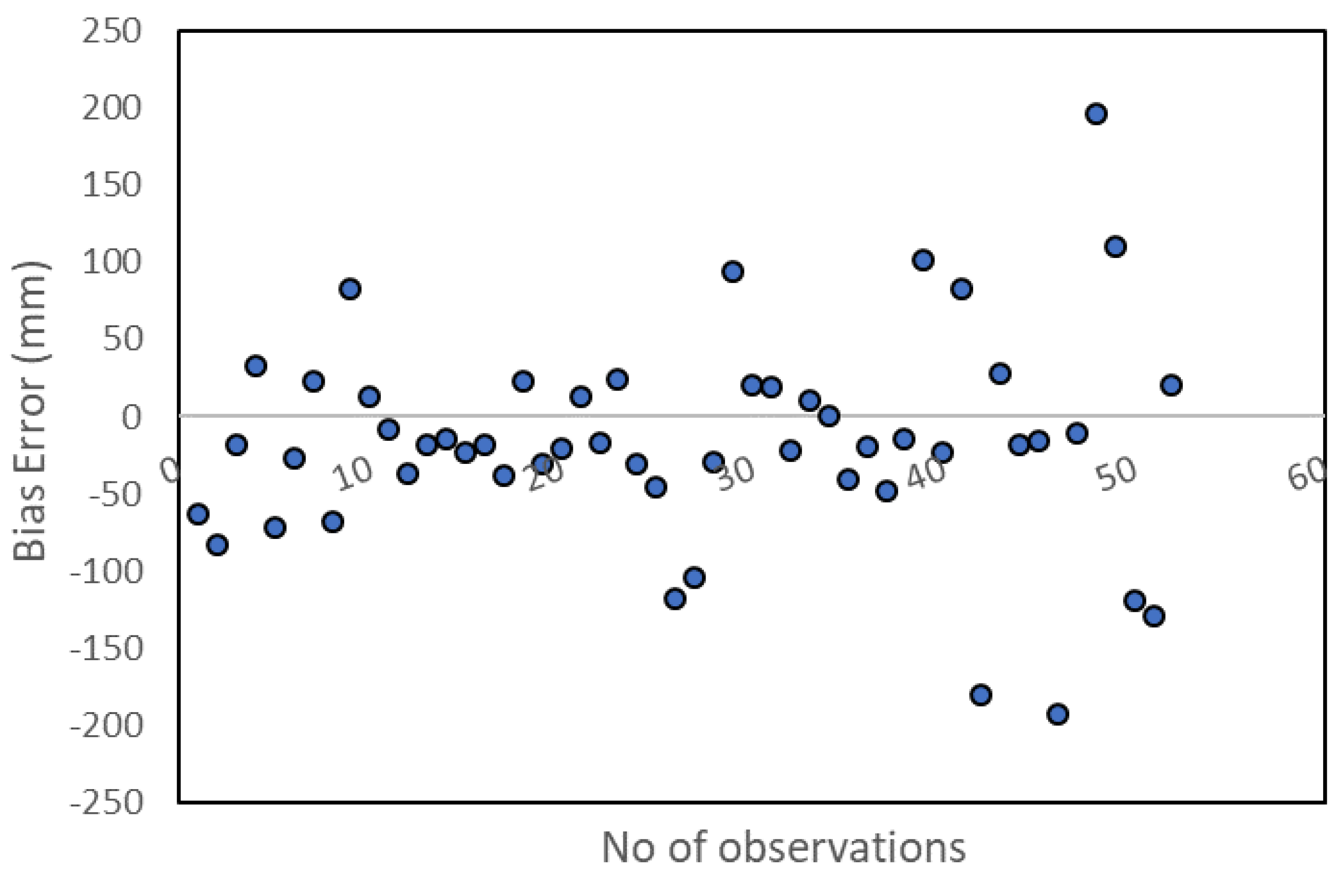
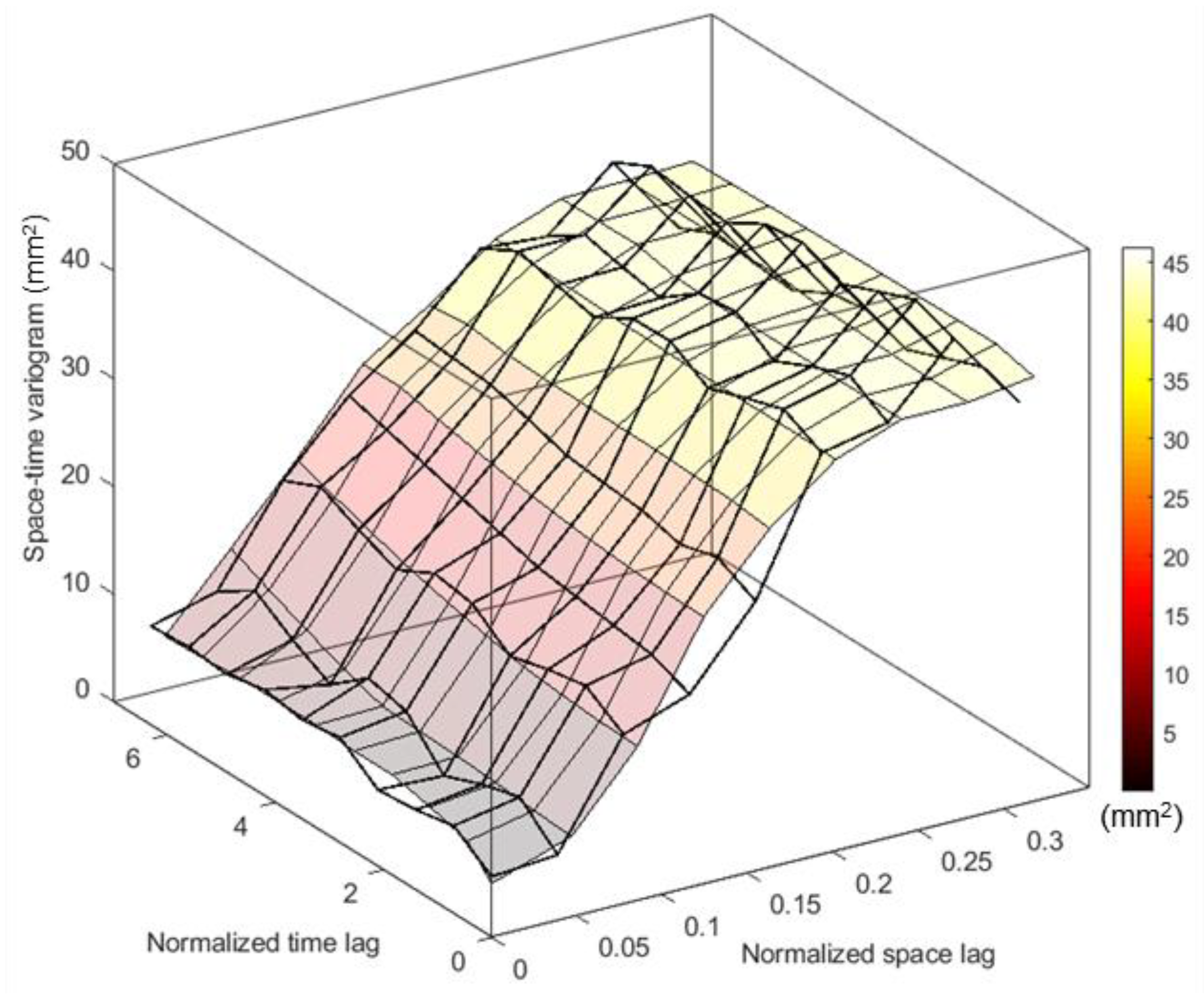
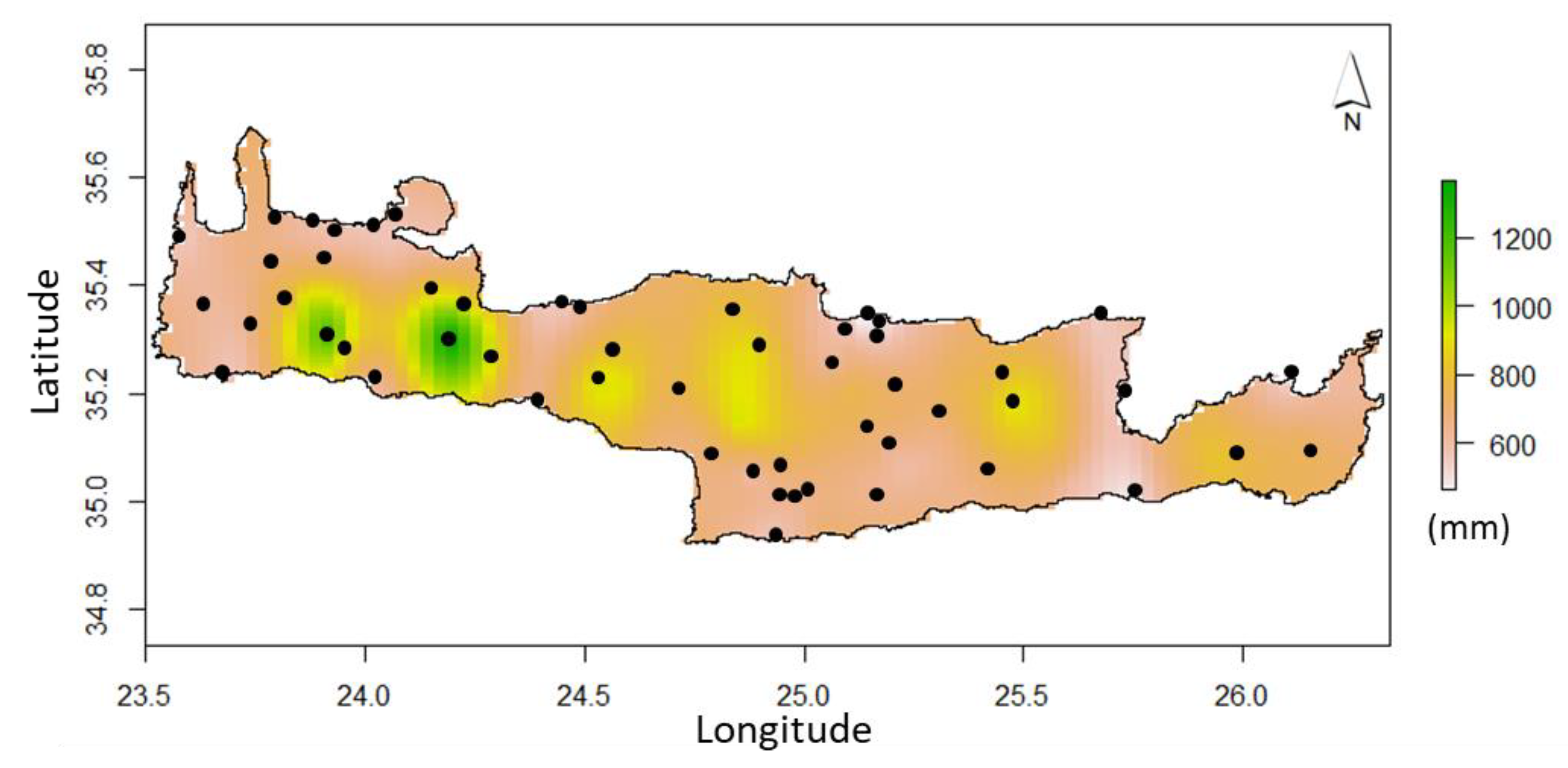
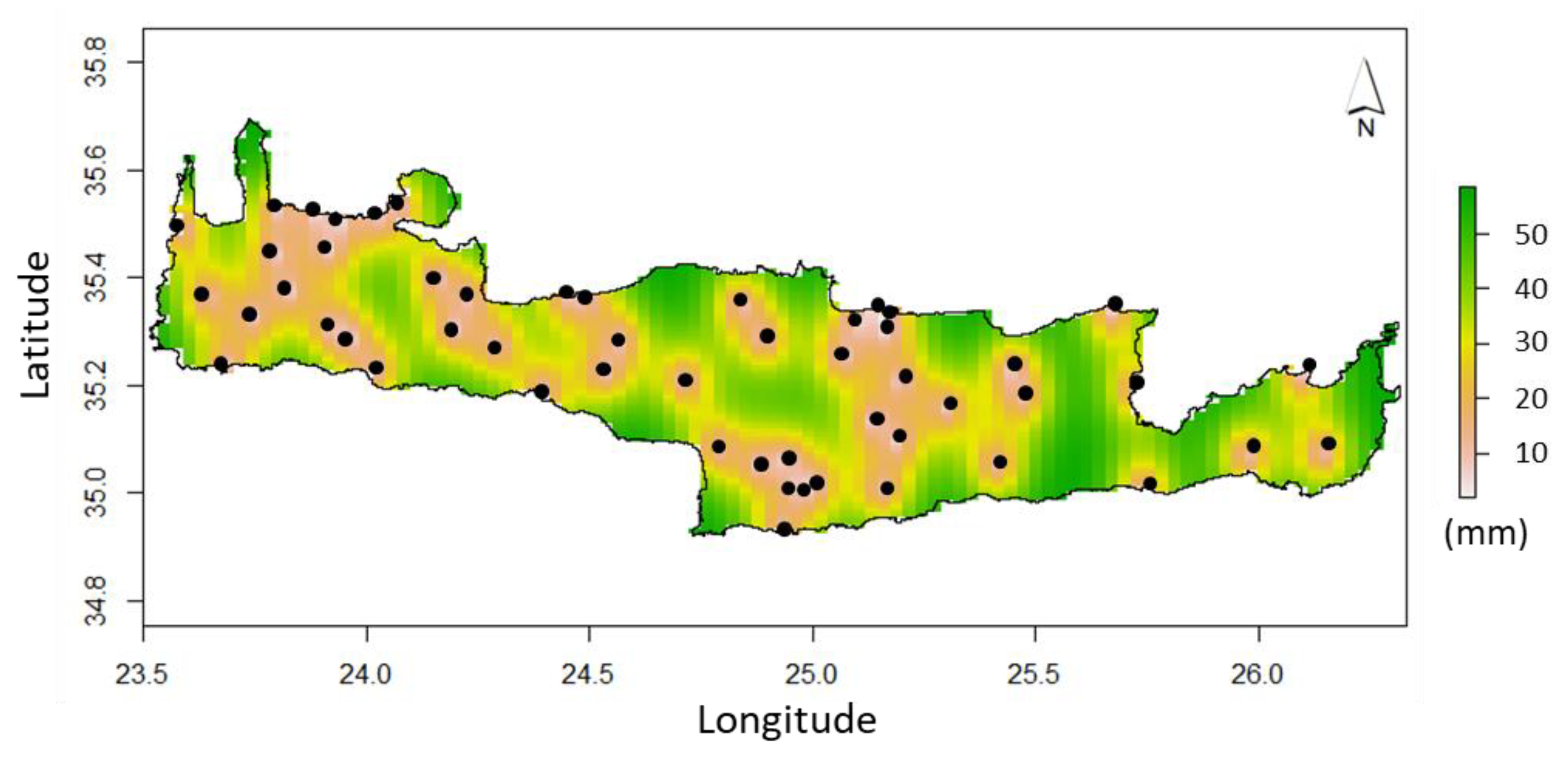
| Method | MAE (mm) | MARE % | Bias (mm) |
|---|---|---|---|
| Space–time residual kriging/sum-metric variogram | 54.30 | 0.11 | −22.13 |
| Space–time residual kriging/product-sum variogram | 59.65 | 0.12 | −25.14 |
| Model | Sill | Range (Correlation Length) | Nugget | α |
|---|---|---|---|---|
| Spatial Gaussian | 36.31 mm2 | 0.25 or 70 km | 5.25 mm2 | |
| Temporal Exponential | 38.16 mm2 | 4 y | 0 | |
| Joint Exponential | 37.24 mm2 | 1.14 | 0 | 0.95 |
Publisher’s Note: MDPI stays neutral with regard to jurisdictional claims in published maps and institutional affiliations. |
© 2021 by the authors. Licensee MDPI, Basel, Switzerland. This article is an open access article distributed under the terms and conditions of the Creative Commons Attribution (CC BY) license (https://creativecommons.org/licenses/by/4.0/).
Share and Cite
Varouchakis, E.A.; Kamińska-Chuchmała, A.; Kowalik, G.; Spanoudaki, K.; Graña, M. Combining Geostatistics and Remote Sensing Data to Improve Spatiotemporal Analysis of Precipitation. Sensors 2021, 21, 3132. https://doi.org/10.3390/s21093132
Varouchakis EA, Kamińska-Chuchmała A, Kowalik G, Spanoudaki K, Graña M. Combining Geostatistics and Remote Sensing Data to Improve Spatiotemporal Analysis of Precipitation. Sensors. 2021; 21(9):3132. https://doi.org/10.3390/s21093132
Chicago/Turabian StyleVarouchakis, Emmanouil A., Anna Kamińska-Chuchmała, Grzegorz Kowalik, Katerina Spanoudaki, and Manuel Graña. 2021. "Combining Geostatistics and Remote Sensing Data to Improve Spatiotemporal Analysis of Precipitation" Sensors 21, no. 9: 3132. https://doi.org/10.3390/s21093132
APA StyleVarouchakis, E. A., Kamińska-Chuchmała, A., Kowalik, G., Spanoudaki, K., & Graña, M. (2021). Combining Geostatistics and Remote Sensing Data to Improve Spatiotemporal Analysis of Precipitation. Sensors, 21(9), 3132. https://doi.org/10.3390/s21093132







